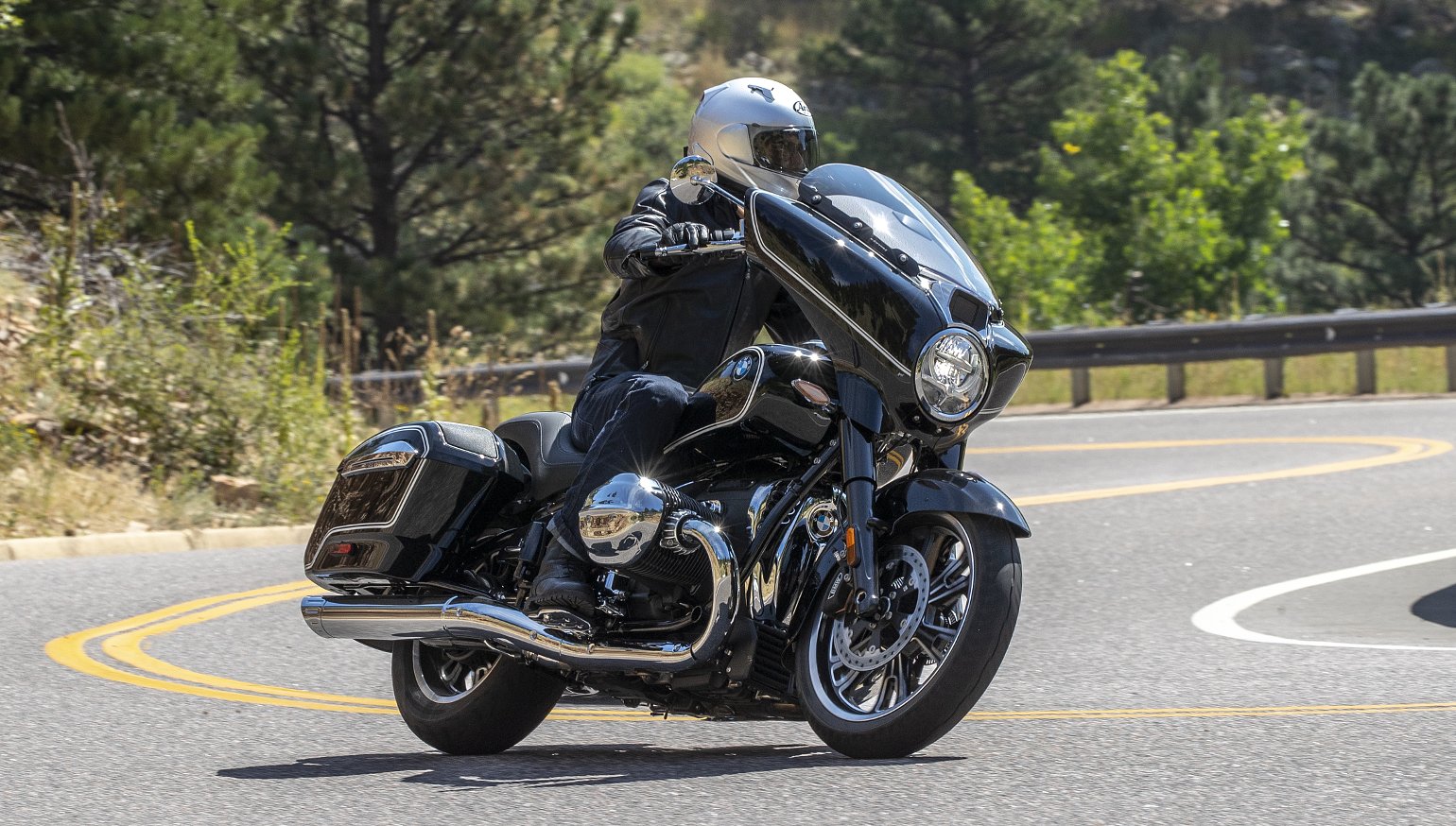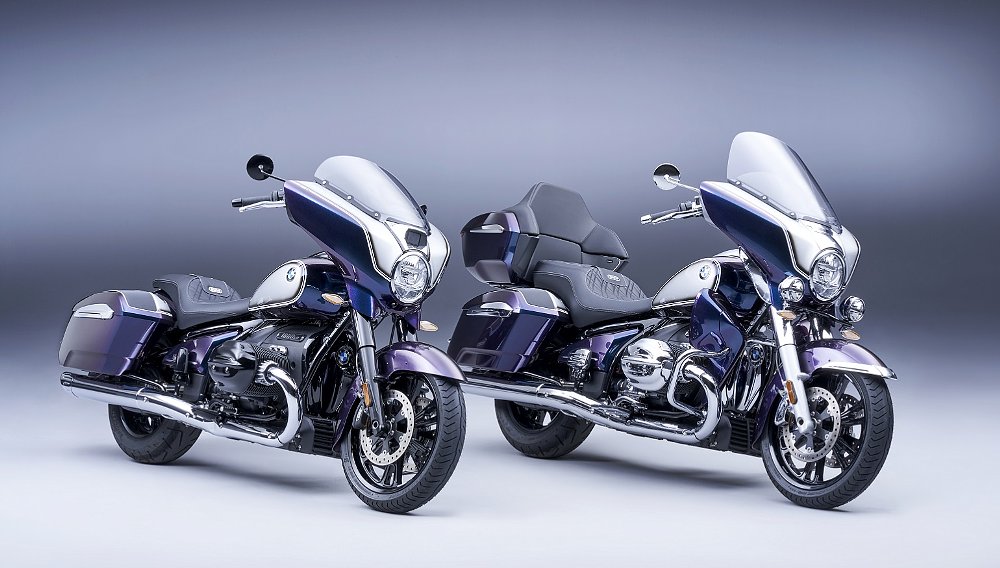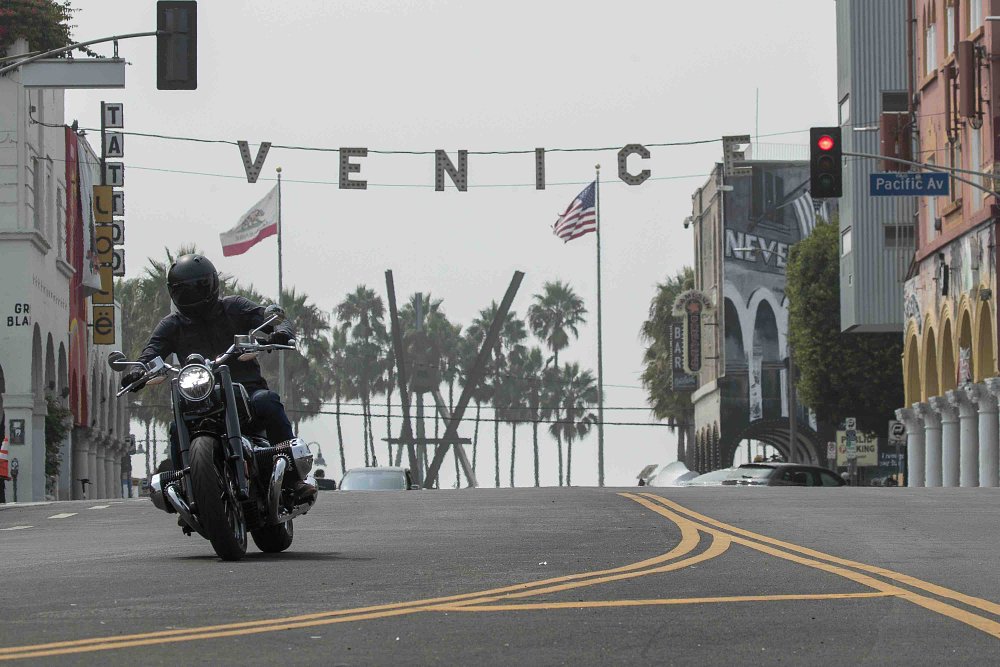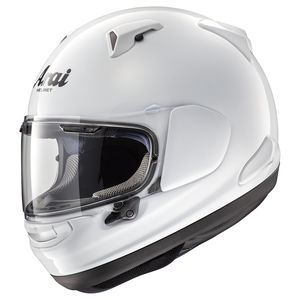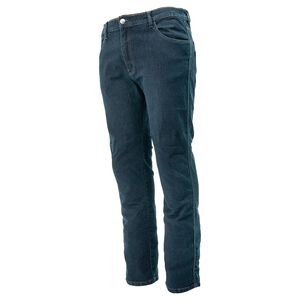BMW makes one of the finest long-haul motorcycles available today. It’s called the K 1600, and like the latest R 18 models, it’s a bike that only BMW would build.
In contrast to the new R 18s, those K 1600s remain firmly in the modern touring class with their inline six-cylinder engines, 17-inch wheels and wind-cheating bodywork. The big K is rational, refined and capable of cannonballing across the continent with the best of them, yet it holds little appeal to the old-school cruiser side of touring. Now, BMW hopes to break into the big twin segment with their new R 18 Bagger and Transcontinental models featuring the same “Big Boxer” that produced the R 18 and R 18 Classic. These land yachts are the largest and most luxurious boxers offered by the Berlin factory. To that point, the base MSRPs are $21,495 for the R 18 B and $24,995 for the R 18 Transcontinental, and those prices can easily approach 30 grand with options like those on our First Edition test bikes.
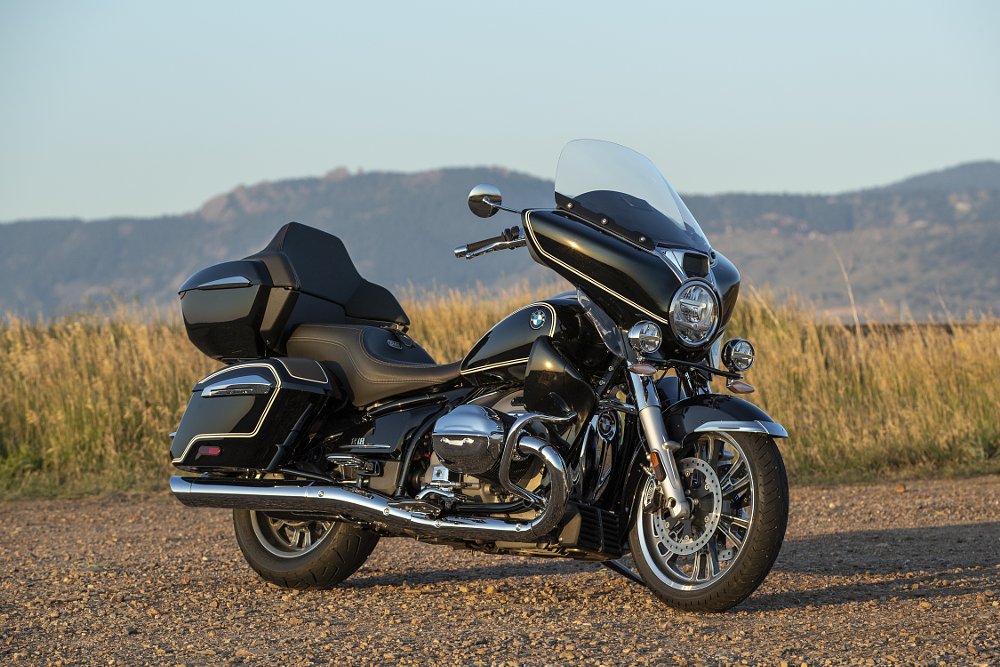
BMW invited me out to Denver for an introductory ride on the new R 18s. The bikes boast a truly unique combination of powerplant, style, and technology, but are they any good?
BMW builds an alternative big twin
While these two models are new to the public, baggers and full dressers were a part of BMW’s internal plan for the heritage cruiser line from the beginning. Peter Nettesheim, Motorrad expert and owner of the world’s largest private collection of BMW motorcycles, was pulled in during the early stages of the R 18 project, and he says he saw mockups of these bikes in Germany more than three years ago.
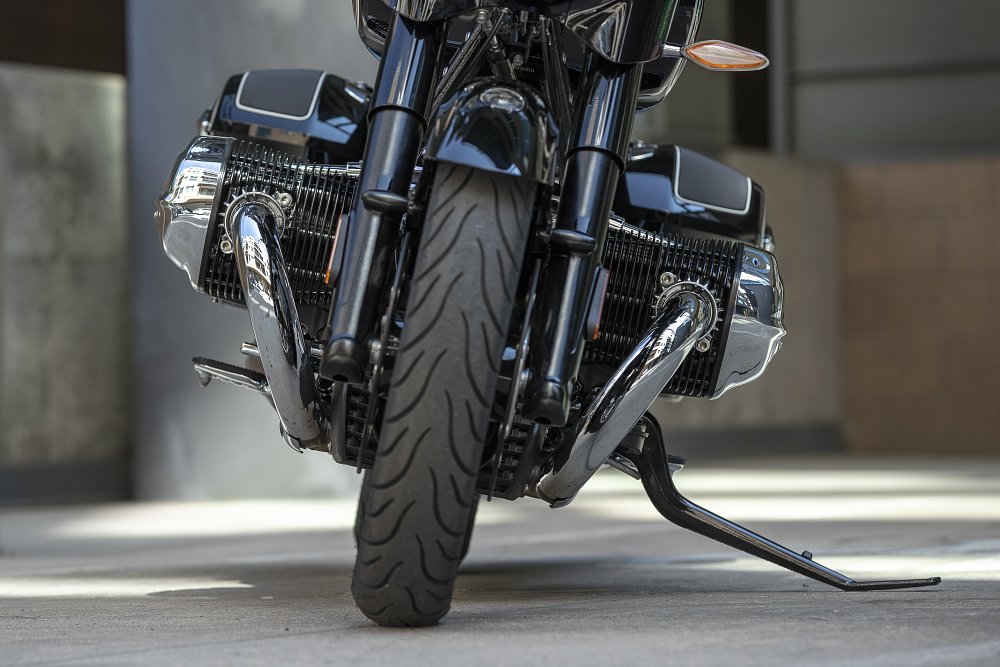
“They came to visit my collection and to talk about the references from BMW history that the bikes should have,” Peter told me. “Of course, the engines had to be boxers. They should use the classic teardrop tank, the white pinstripes over black paint, and double loop frames with exposed driveshafts. I also hoped that they would use reverse levers that pivot from the ends of the handlebar, but developing them would be too expensive for the bean counters."
You might be wondering why BMW's building cruisers like these in the first place with the dual headwinds of history and Harley-Davidson. Part of the answer lies with the behemoth Big Boxer engine, which was developed to power their retro cruiser conquests. The B and Transcontinental will sit at the peak of BMW’s heritage range as the ultimate celebrations of boxer spirit. Almost like a flattering self-portrait later in life.
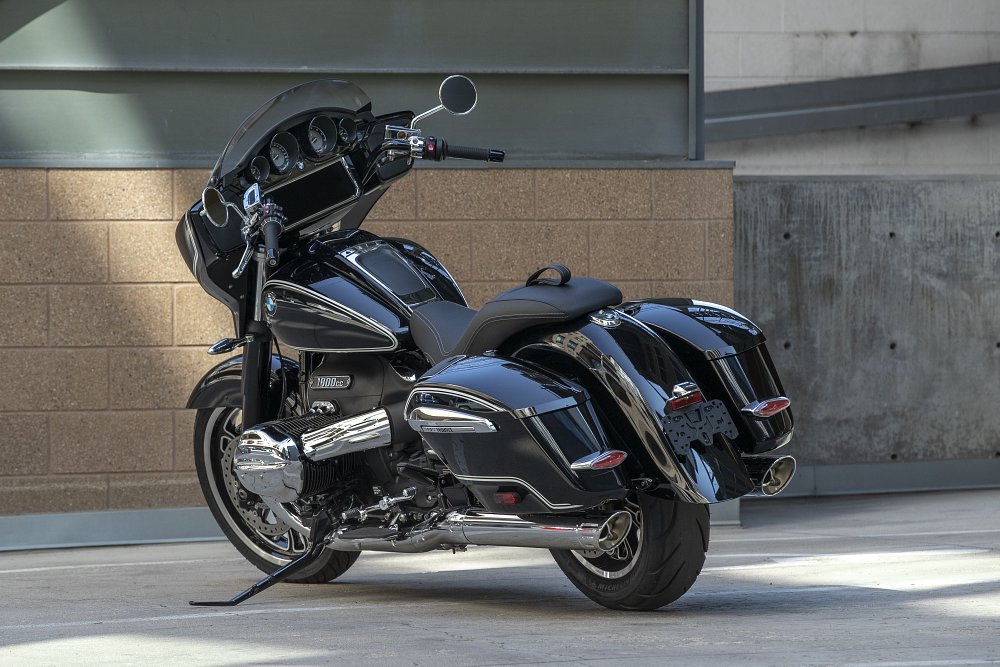
Another driving force was the allure of the cruiser market, specifically in the United States, where riders are willing and able to buy bikes like these. Indian has made inroads into Harley-Davidson’s position, so BMW figures there are a fair few other customers who want a traditionally styled, high-end cruiser beyond the usual from Milwaukee. BMW's market research found that both bagger and dresser buyers overwhelmingly prefer premium products, yet Harley has barely any direct competitors for their big bikes. Besides, if H-D can build an ADV bike, then surely BMW can build luxury cruisers with their beloved new mill.
The results are two gleaming Bavarian hulks that combine some of BMW’s best technology with familiar bagger and dresser silhouettes. If the whopping R 18 engine made sense anywhere, it would have to be these bikes: big torque, lots of character, air/oil-cooled, and firmly in the heavyweight class.
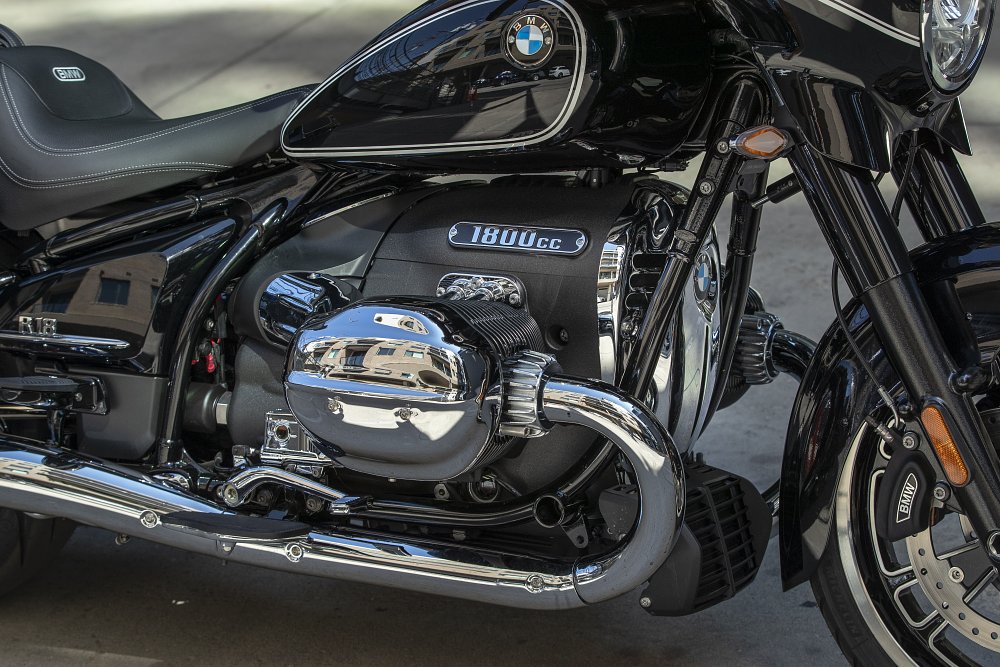
Engine and transmission
The 1,802 cc flat twin powering these bikes is the centerpiece of the R 18 experience. It produces 91 horsepower at 4,750 rpm, and a respectable 116 foot-pounds of torque at 3,000 rpm, where the engine is happily churning along. This pushrod engine takes premium fuel, offers six speeds and produces 660 watts from its large alternator. The bagger and Transcontinental use the same drivetrain, clutch, and tune as the base R 18 model Zack reviewed last year. Power is predictable and linear, pulling right off idle and well into the midrange before the power signs off around 4,500 rpm. Even though the R 18 will keep revving beyond that point, you’d be looking for something that isn’t there.
The powerplant has Paul Bunyan presence from any angle. The chrome valve covers are the size of dinner plates and the shining driveshaft is bare for all to see. The R 18 is simply one of the most striking motorcycle engines available today. Unfortunately, that comes with a weight penalty of 244 pounds, as well as physical limitations for the design of the motorcycle carrying it, such as the inability to mount forward controls and the minimal clearance between pedals and cylinder heads.
Chassis and suspension
The R 18 B and Transcontinental use a modified version of the standard R 18’s frame with additional reinforcements, plus a revised steering head angle for steeper rake and reduced trail to improve low-speed maneuverability over the standard and Classic variants. The two new bikes use an unconventional triple tree arrangement that actually places the fork tubes behind the steering stem to achieve the desired geometry.
Both bikes have an auto-leveling rear monoshock that responds to load changes from passengers and cargo. The 4.7 inches of travel, both front and rear, give a little more cornering clearance and comfort over the previous two models in the R 18 line.
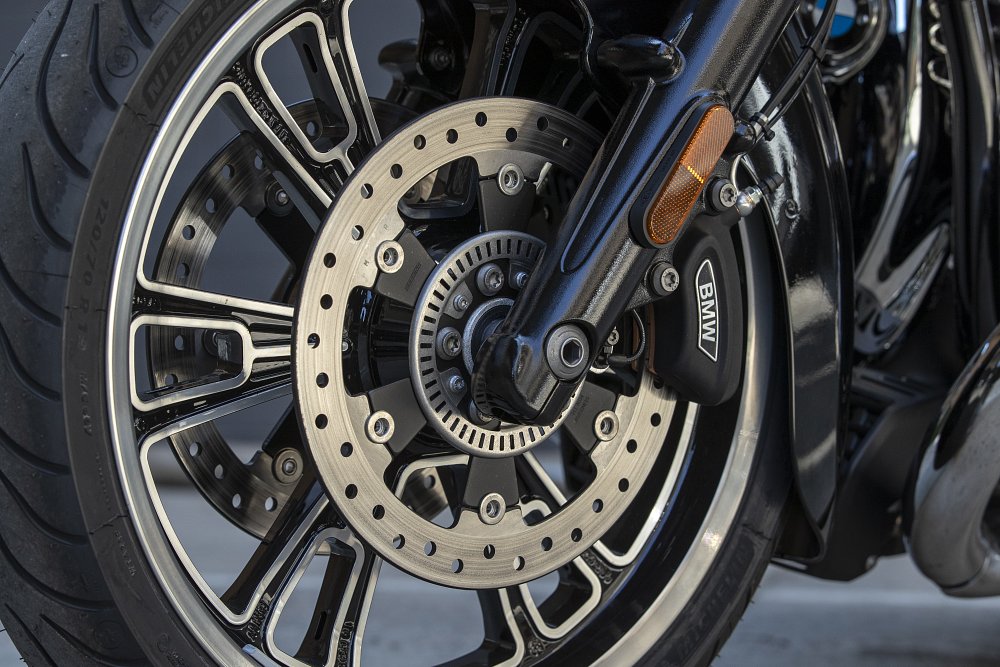
Wheels and brakes
The B and Transcon roll on cast wheels (19-inchers up front and 16s in the back) wrapped in Bridgestone Battlecruise H50s. Two front discs and one rear, all 300 mm in diameter, use four-piston calipers to haul these cruisers to a stop. Brakes are linked, because these bikes are certifiably hefty at 877 pounds wet for the B and 942 for the Transcontinental. I’ll get to riding impressions in a minute, but this is a good place to mention that the brakes are totally adequate for these bikes.
Dash and technology
The most remarkable aspect of the R 18 B and Transcontinental might be the juxtaposition of its old-school bones with its integrated suite of top-shelf technologies. Dynamic Cruise Control (no overacceleration on downhills) is standard, along with heated grips, ABS, full LED lighting with mechanical cornering illumination, and Marshall Gold audio. Optional features include radar-powered Adaptive Cruise Control, Hill Start Control, upgraded speakers, adaptive headlights, reverse assist, central locking, a security system, and TPMS, depending on which packages the customer selects. BMW is the only classic cruiser manufacturer to offer this combination of features and that makes the R 18 the technophile’s choice in its class.
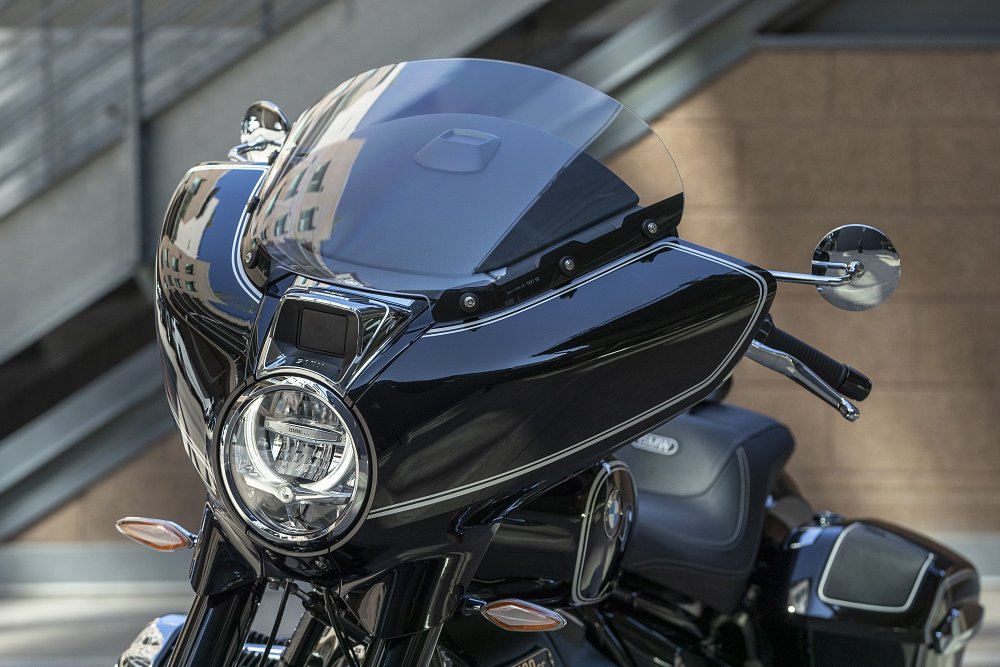
The middle of the tank has two pop-up covers that release with a wide toggle button. The top hides the gas cap, while the bottom reveals a waterproof phone compartment with a USB-C connection to keep your device charged while you ride. The phone interfaces with the R 18’s brain using BMW’s Ride Connected app. Phone calls, music, navigation and other essential functions are relayed through Ride Connected to the generous 10.25-inch display. Wireless (inductive) charging was not used because phone temperatures ran too high in testing, even with the integrated cooling fan on full blast. My Pixel 4 fit with no issues with the case still attached; another rider in my group couldn’t fit his iPhone 12 Pro Max.
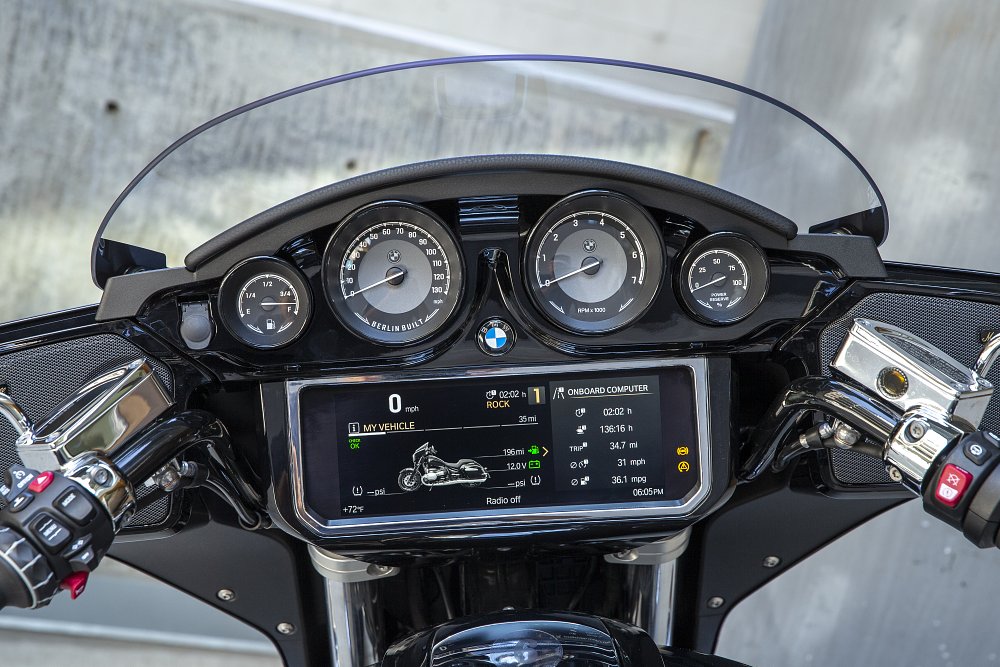
The screen is the command center for all the bike’s advanced functions, and it’ll even run up to three of them in split-screen. BMW deserves praise for the clarity and glare resistance of this class-leading display. Navigate the deep menus and settings with the “magic wheel” multi-controller and buttons on the left grip. Initially a bit clunky, I was changing settings, channels, and functions easily by the end of our ride.
Above the screen, round gauges for the fuel level, speedometer, tachometer, and “Power Reserve” sit at the lower edge of the rider’s vision while in the saddle. What’s Power Reserve? That’s a feature lifted from another BMW property, Rolls Royce. Puttering around town will barely move the needle, and a full throttle pull will send it to zero. It’s a novelty, but when someone inevitably asks what the dial does, you get to explain that your Beemer has Rolls Royce connections. Personally, I’d rather see a simple fuel economy gauge. Neat touch, though.
Let’s put that power to the road and try it out.
Riding impressions
I started the day on the R 18 B, and because we’d hit the route’s tightest roads before lunch, that was fine with me. Tapping the “power up” button on the right switch pod wakes the sprawling dash, and a quick push of the starter lights off the boxer below. A few quick thuds, followed by a little torque twist to the left, settles down to a steady thrum. If you haven’t ridden a boxer before, engines with cranks parallel to the bike's centerline are known for that little “roll” when you give a rev at a standstill. It isn’t alarming or dangerous — just a family trait that makes BMWs, Guzzis and other bikes with this crank orientation feel special.
The bagger had good manners around town, thanks to its low seat height, subterranean center of gravity and reasonably easy clutch pull. And on steep streets, BMW’s optional hill assist lets the rider focus on traffic ahead, not whatever’s waiting behind. The toe shifter on my test bike was annoying to upshift. Downshifts at the heel weren't much better with the lever's odd height. The shift levers are separate and fit to a splined shaft with some room for adjustability, so your dealer may set them up differently. Expect to use that shifter, too — I had to change gears with more frequency than I expected when riding rolling roads at over 50 miles per hour.
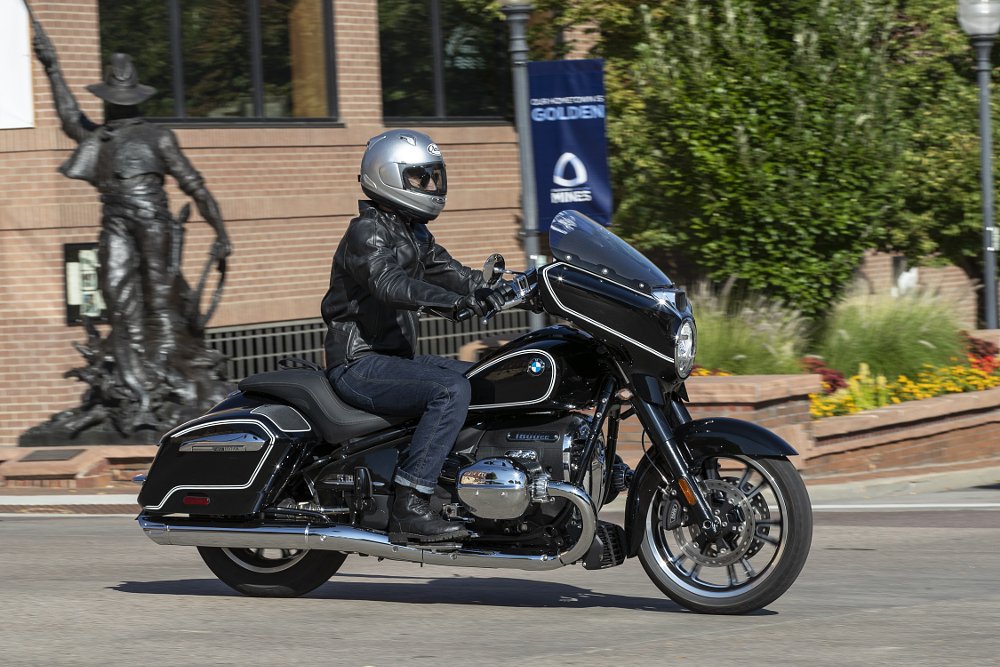
The R 18 B and Transcontinental feature three ride modes: Rock, Roll, and Rain. Most riders will probably spend their time in Roll with its linear power and Goldilocks responsiveness. The Big Boxer is grunty, smooth, and whines like a turbine on decel with little burbles. Rock doesn’t feel like it delivers any more power. Instead, it makes the throttle more abrupt and practically unusable in tight quarters. I tried using it on open roads later in the day to spice things up, only to end up back in Roll where the bike seemed happiest. Rain severely neuters power and response. I would definitely use it to guide an R 18 home in a storm.
After clutching and duck-walking our way through traffic, we left Denver city limits and reached the R 18’s natural habitat: the open road. The bagger stays positively planted, which gave me one less thing to think about as I explored my test bike’s premium features, starting with the sound system. Sadly, the mids and bass of the Marshall speakers wash away at speed, just like most other integrated systems. Upper mids and treble hang around up to the bike’s top speeds, so I could still listen to Tom Petty at 80 mph. To the sound system’s credit, it’s much better at lower speeds after a few minutes in the settings menu. I’d rather have a nice Bluetooth headset and the extra room in my saddlebags for more snacks than the upgraded speakers with how I'd ride it 90 percent of the time.
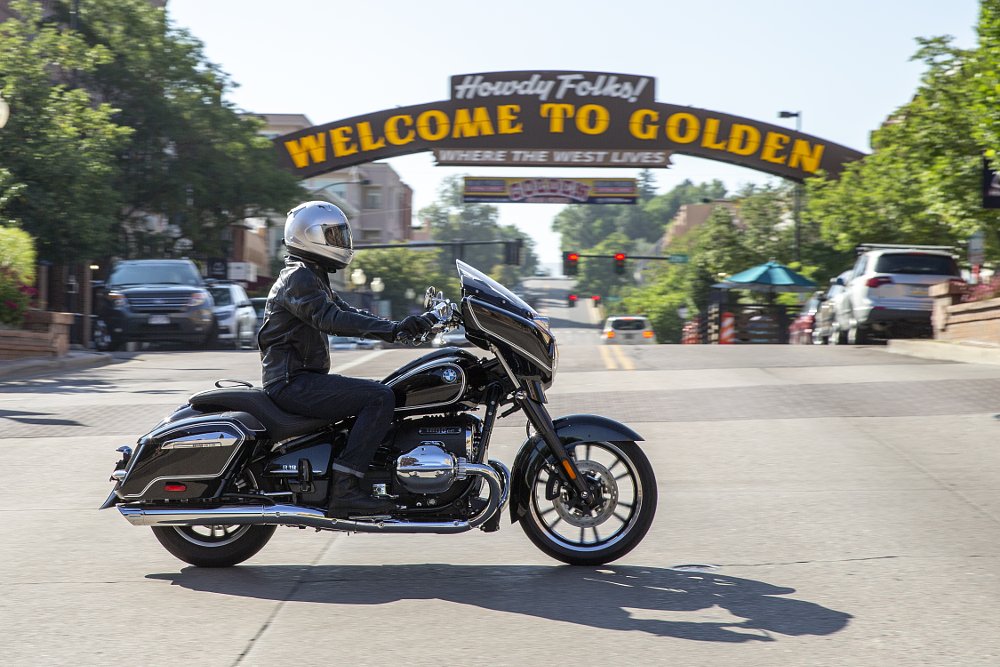
Next up was the Adaptive Cruise Control. With this system, the rider starts with the left switch pod to set the cruise control’s upper speed limit. The standard Dynamic Cruise Control can be used normally, or the rider can toggle it to Adaptive mode. A radar module above the headlight keeps tabs on other road users and automatically adjusts the bike’s speed to maintain distance. You can even adjust following distance and the abruptness of speed alterations. Technophile's choice, remember?
On top of that, this system doesn’t just decrease engine speed to make the adaptive magic happen. ACC can activate the brakes down to 19 mph (per BMW’s literature, not my testing) if the trailed vehicle makes sudden changes. The ACC experience is fantastic in use. Sure, it was a little spotty at times when riding in formation with other bikes, but ultimately BMW knocked it out of the park with this tech, and I can’t name another traditional cruiser that can match it. The touring and sport-touring segments have already shown how valuable this tech can be for those putting down big miles with their machines. Nice work, BMW.
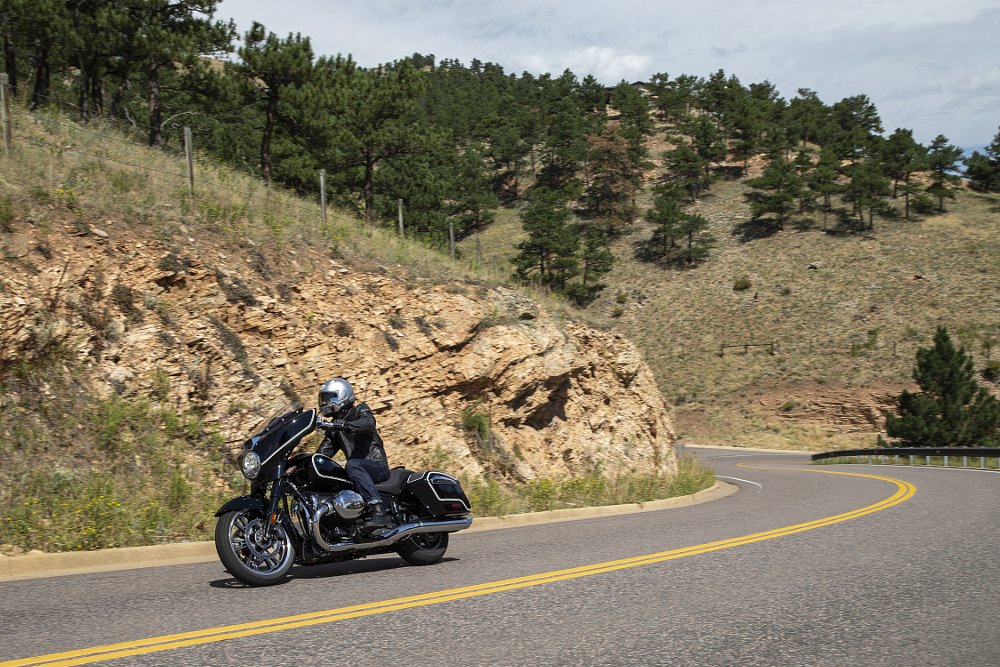
As we passed through Boulder and up into Roosevelt National Forest, I turned ACC off and spent my time getting to know the bike on sweeping mountain roads. Both models are blessed with superb handling for their weight. Like other large cruisers, they are cumbersome at walking speeds. That heft disappears once they’re rolling. BMW got the suspension right with a firmer approach than usual for the class. This means the bikes hold their lines very well up to the point of floorboard-pavement contact, and there will be pavement-floorboard contact. Lots of it.
A little body English will extend the life of the R 18’s hard parts, and considering the size and exposed cylinder heads of these motorcycles, I’m not sure how much farther I’d want to push them, anyway. Those who ride aggressively will quickly tire of gouging the road. Riders who enjoy a milder pace shouldn’t have much issue if they can overlook the frequent scraping. Skrrt, skrrt. I left about 50 cents’ worth of floorboard feeler steel on a snaking section of our ride. Engine and floorboard positioning are the biggest limiting factors to the bike’s otherwise-excellent handling.
After stopping for food, I swapped to a Transcontinental, and the bike felt like it had as much for lunch as I did. The handling and cornering were just the same as the bagger's, though the seat was a mite comfier, and the extra weight wouldn't be an issue if I routinely rode two-up. Passengers get footpegs on the B and 'boards on the Transcontinental.
As the test ride came to a close, and our group made very good time down a Colorado freeway, I threw on the ACC, leaned back against the Transcontinental's saddle, cranked up the tunes, and rested my boots on the chrome engine guards. (There is an accessory footrest/boot protector available for this. I didn't have one.) My half ton craft sat in the engine's sweet spot where it balances out and hums. The Transcon's windshield was nearly high enough to fully isolate me as we crossed the foothills back to Denver (which made me realize an adjustable windshield would be nice on the bagger).
This was a riding experience that no other motorcycle that I know can provide: rumbling boxer power, controlled by computer brains and a radar array working together for a kind of German magic carpet ride, all set to a soundtrack of Americana. If that's something you'd like to try, it can only be found at your BMW dealer.
Expensive, luxurious, and limited
Final thoughts? The R 18 engine suggests more power than it actually delivers, and that's a big strike for cruiser riders with something to prove. If you want a motorcycle that has more power than anyone else's on your next group ride, this ain't it. The R 18 feels like a good match for the style and intent of the R 18 B and Transcon, but it falls short of awing anyone with thrilling torque. The character is not so compelling that you'd forgive that, either. These bikes need more power or less weight if the legroom and lean angle limitations are non-negotiables, especially against Harley's established lines of bagger and touring motorcycles.
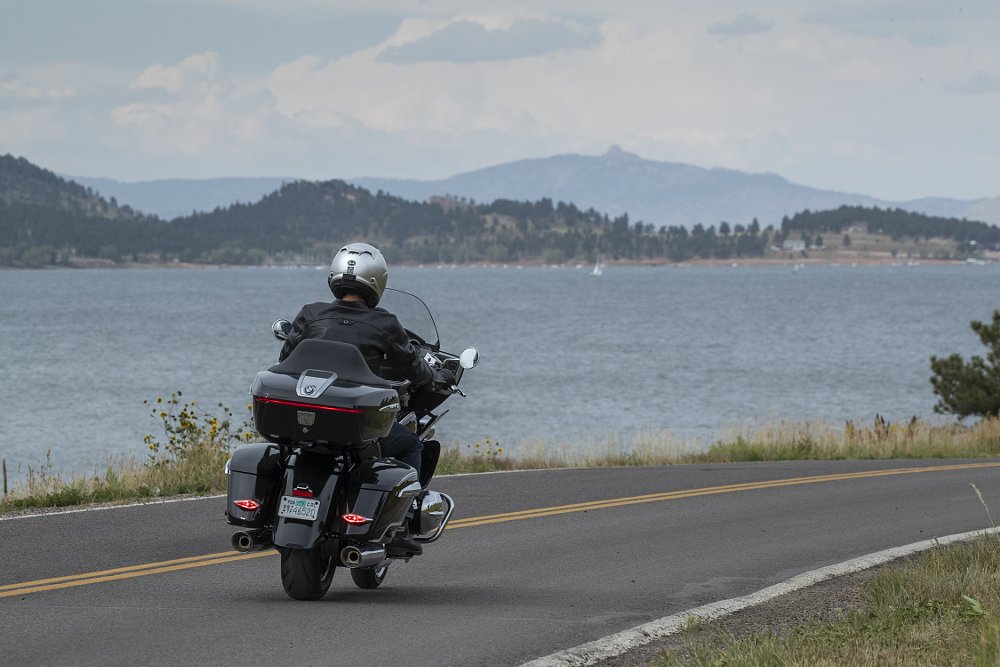
That said, BMW isn't trying to outsell Harley-Davidson here. They have a unique engine and class-leading technologies from other projects, so they brought them together in a new way to appeal to select customers. Maybe that buyer isn't into the Harley image, or maybe they've owned several big V-twins over decades of riding, and want a change in the garage. Maybe their idea of luxury touring is enjoying the very latest in infotainment and rider comfort technologies, not bolting Screamin' Eagle parts onto their ride. How many of these well heeled buyers are there, and how many R 18s does BMW intend to sell? BMW didn't give exact figures, but they did mention that their Berlin factory is cranking out B and Transcon models to get them into showrooms as soon as possible.
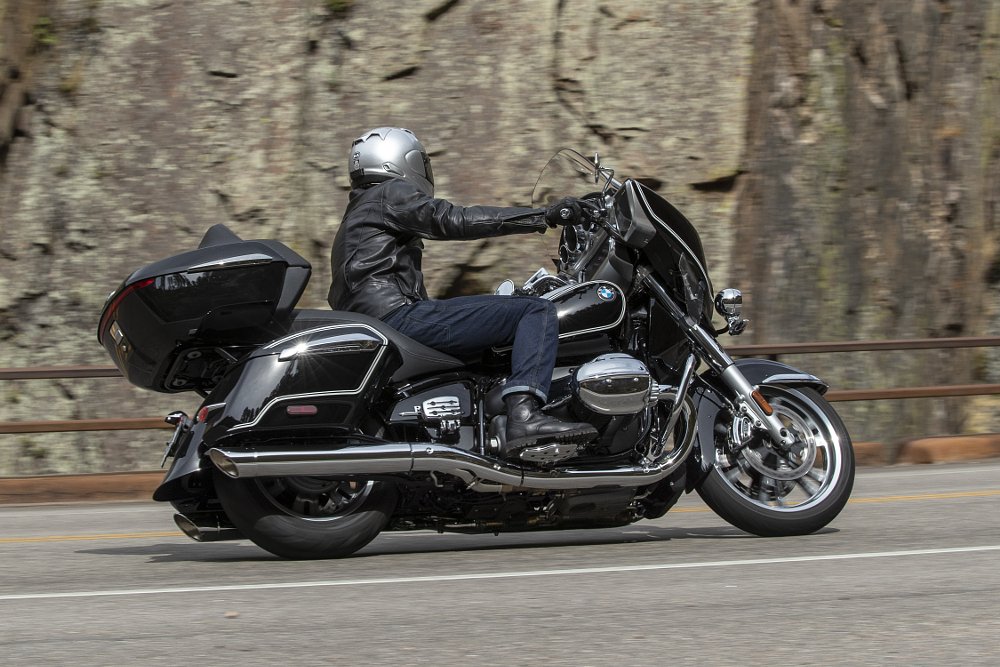
Half throwback, half cutting edge, the R 18s seem destined to become cult classics. The B and the Transcontinental make far more sense than the standard and Classic R 18 models below them, and yet they still make me wonder what BMW was expecting when they started down this road. The result isn't a motorcycle you buy because it's better than a Harley or Indian, unless you're looking for state of the art tech on your big twin, in which case it is better. No, you buy these bikes because they're unlike anything on the road.
R 18 Bs and Transcontinentals are available in Black Storm Metallic, First Edition Black Storm Metallic (with white pinstripes), and the opulent Option 719 Galaxy Dust Metallic/Titan Silver 2 Metallic at a $2,500 premium. Manhattan Metallic Matte, which is a flat, earthy color, will be available about a month after the other bikes hit.
|
2022 BMW R 18 B and Transcontinental
|
|
|---|---|
|
Price (MSRP)
|
$21,945 (base B), $24,995 (base Transcontinental)
|
|
Engine
|
1,802 cc, air/oil-cooled, eight-valve, horizontally opposed twin
|
|
Transmission,
final drive
|
Six-speed, shaft
|
|
Claimed horsepower
|
91 @ 4,750 rpm
|
|
Claimed torque
|
116 foot-pounds @ 3,000 rpm
|
|
Frame
|
Steel tube double cradle
|
|
Front suspension
|
Showa 49 mm fork; 4.7 inches of travel
|
|
Rear suspension
|
Monoshock, auto load-leveling; 4.7 inches of travel
|
|
Front brake
|
Two Brembo four-piston calipers, 300 mm discs with ABS
|
|
Rear brake
|
Brembo four-piston caliper, 300 mm disc with ABS
|
|
Rake, trail
|
27.3 degrees, 7.2 inches
|
|
Wheelbase
|
68.1 inches
|
|
Seat height
|
28.35 inches (B), 29.1 inches (Transcontinental)
|
|
Fuel capacity
|
6.3 gallons
|
|
Tires
|
Michelin Commander Touring III; 120/70R19 front, 180/65B16 rear
|
|
Claimed weight
|
877 pounds wet (B), 942 pounds wet (Transcontinental)
|
|
Available
|
Now
|
|
Warranty
|
36 months / 36,000 miles
|
|
More info
|
|

 Membership
Membership

